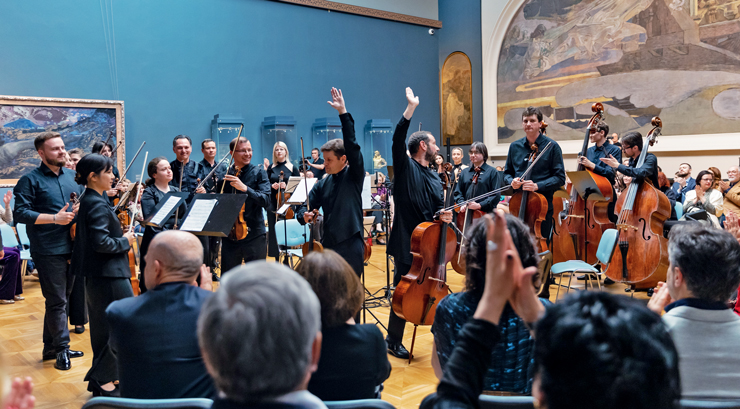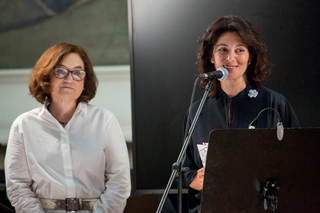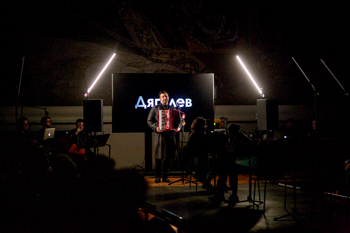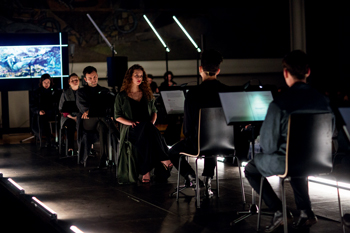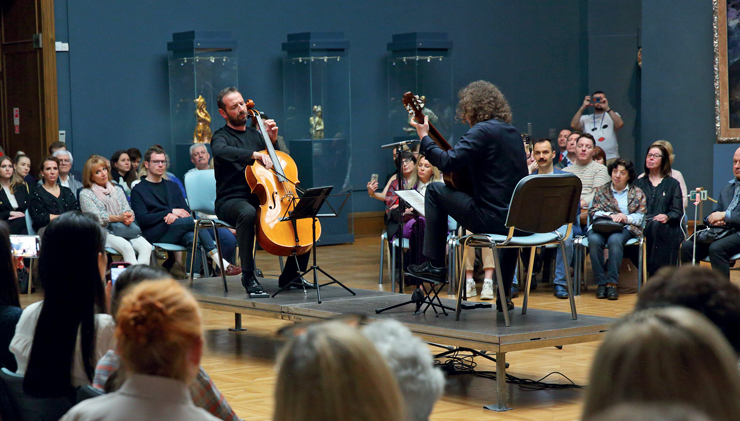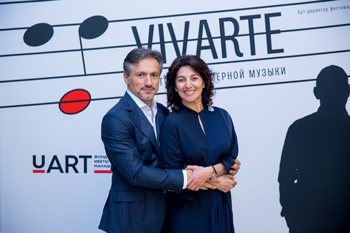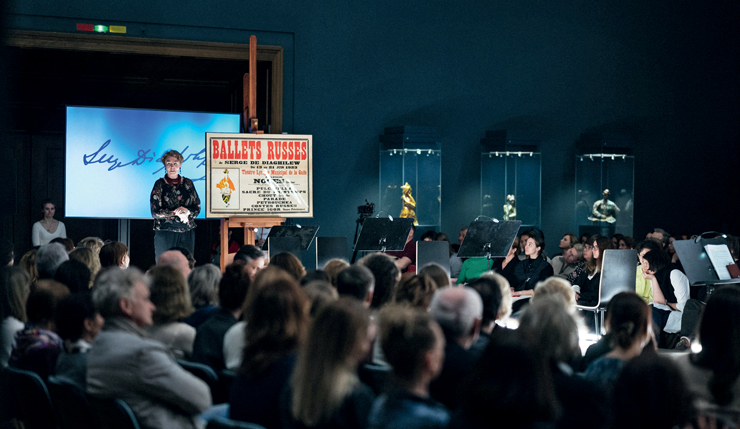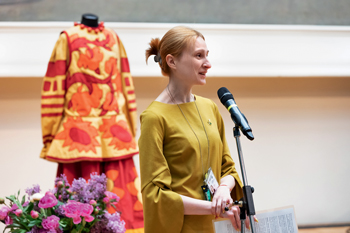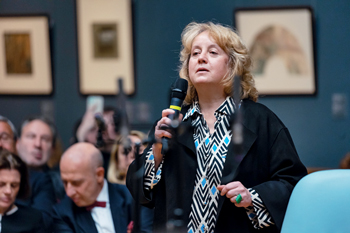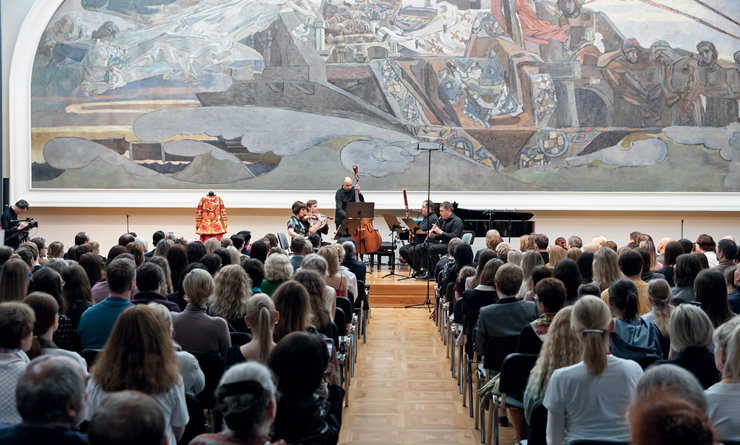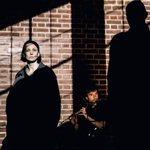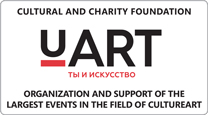VII Music Festival Vivarte — “Hommage à Diaghilev”
The joint creative project of cellist Boris
Andrianov, the Tretyakov Gallery and the Foundation U-ART, which from the very
beginning included in its concept the idea of the universal and expanding
horizons, could not miss the anniversary of the man who became an all-round
performer of the highest level – Sergei Diaghilev. 31 March 2022 was the 150th
birthday of the great impresario
Text: Tatiana Davydova
Photo:
Iulia Zakharova, Vladimir Volkov, Denis Kuznetsov, Viktor
Kriak
|
The festival's finale is the etude “Metamorphosen” for 23 solo strings by Richard Strauss |
Diaghilev was always in a creative search, looking for new ways, trying his hand at different roles. “I am an artist without any paintings, a writer without any collected editions, a musician without any musical works,” he said, but it was nothing more than a cunning. He played the piano perfectly, studied singing seriously (and even entered a conservatory for vocal studies), composed music and intended to become a professional composer. With his phenomenal memory and extraordinary flair, he became a deep expert in the fine arts and a keen connoisseur of literature. He had an excellent understanding of choreography and fashion, and best of all, as it turned out later, of the mechanisms of cultural revolutions.
|
Zelfira Tregulova, General Director of the State Tretyakov Gallery, and Iveta Manasherova, President of Vivarte Festival |
His life was an example of daring flight, endless research
and endurance tests, and far from always he sought to “prove harmony by
algebra,” quite often he did the opposite. The broadmindedness
However, it was not only the unified nature of the programs that made the 2022 festival different from the previous ones. Although for objective reasons it included only three events instead of the usual seven, each was quite extensive.
The space of the festival site, the Vrubel Hall of the Tretyakov Gallery, has also been transformed: on the first day it became a theatrical stage, hosting the performance “Diaghilev”.
|
Diaghilev's life was an example of a daring flight, endless research and endurance tests …
|
Director Pavel Seplyarskiy introduced to the audience that
surrounded the stage the young members of the World of Art movement –– Sergei
Diaghilev himself and his associates Dmitry Filosofov, Léon Bakst, Alexandre
Benois, Valentin Serov, Zinaida Gippius and others, he used for his characters
ironic dialogues from Maria Druzhinina's play “Breakfast with Diaghilev” and
with the help of videographer Ekaterina Bessmertnaya complemented the action
unfolding
Pavel Seplyarsky called the performance shown at the Tretyakov Gallery “a work for the future,” expressing his intention to expand and enlarge the production in order to present it on the large theatrical stage. The performers were warmly received. “It seems to me that the reaction of the audience is lively and the things we laid out in the performance were welcomed, understood. At least, that is the first impression I felt from the viewers,” the director noted. This production tells the story of the creation of the Mir Iskusstva magazine and serves as a kind of prequel to the era of the legendary Russian Seasons, and the theater performance itself refers to the subsequent concert programs of Vivarte, associated entirely with the works of Diaghilev and the Ballets Russes in Paris.
|
The festival opened with the performance “Diaghilev” based on the play by Maria Druzhinina |
The performance is the story of the birth, peak, and decline of the Mir Iskusstva (“World of Art”) creative movement. |
The programs of both concerts consisted mainly of works by composers engaged by the Diaghilev troupe. The first place among the entrepreneur's regular creative partners and associates belongs to Igor Stravinsky, whose name is associated with revolutionary breakthroughs in musical theater, the loudest scandals and the greatest triumphs of the Russian Seasons. Diaghilev called Sergei Prokofiev his “second son”, and Prokofiev wrote four different ballets for his troupe: Ala and Lolly, Chout (The Jester who…), The Prodigal Son and The Steel Step (a work about the proletariat staged in constructivist settings).
|
Boris Andrianov and Dmitri Illarionov. Sonata in A Minor by Antonio Vivaldi Arranged for Cello and Guitar |
Another important author for Diaghilev was Nikolai
|
Iveta Manasherova and Tamaz Manasherov, creators of the Foundation U-ART |
Along with young authors, he sometimes turned to recognized figures such as
Richard Strauss, his work “Til Eullenspiegel’s Merry Pranks” appealed both to
the choreographer and dancer Vaslav Nijinsky. The festival also celebrated the
innovative composers who did not write for the theater, but were highly praised
and promoted by Diaghilev. Among them was his peer Alexander Scriabin.
The most difficult task for a chamber music festival like
Vivarte was to select ensemble works. After all, Diaghilev's performances were
accompanied by music, which implied the participation of a large symphony
orchestra. Boris Andrianov, Art Director of the festival, found
Firstly, some authors (like Stravinsky or Prokofiev)
reworked their orchestral scores for smaller ensembles in order to prolong
their stage life. Other composers (like Franz Hasenöhrl or Efrem Zimbalist)
created virtuosic concert fantasies based
|
“It is the first such experimental experience for us. Yet Diaghilev himself was not afraid of experimentation in his life and was always trying something new.” Iveta Manasherova, President of Vivarte Festival
|
Ultimately, the inclusion of masterpieces of chamber music gives a great insight into the compositional styles that Diaghilev loved, and one of the best examples of this is the Sextet by Francis Poulenc.
Sonata by Antonio Vivaldi, the Italian composer whose creative genius was born and blossomed in Venice, played a symbolic role during the festival’s final program.
Venice became for Diaghilev a sacred place, where he spent many years on vacation and there he found his final resting place. On the gravestone of the great impresario, the words are carved: “Venice is constant inspiration of our pacification.” The finale of Vivarte was the famous etude Metamorphosen for 23 solo strings by Richard Strauss, with whom Diaghilev had worked in the 1910s. The composer's last symphonic opus, created in 1945, was a very personal response to the political and military events of the time, and its nature reminds of both a mournful ode and an elegiac poem.
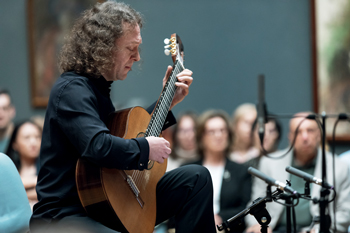 |
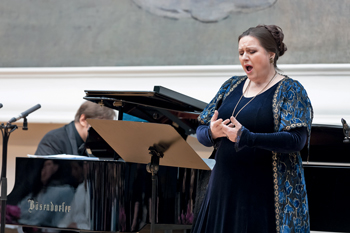 |
|
Guitarist Dmitri Illarionov |
|
Boris Andrianov assembled a remarkable team of musicians to perform programs in which not a single composition could be described as unnecessary or redundant. The group included soprano Yana Ivanilova, pianist Peter Laul, violinists Elena Revich and Marina Katarzhnova, dommer Ekaterina Mochalova, guitarist Dmitri Illarionov, contrabassist Pavel Stepin, clarinetist Igor Fedorov, oboist Olga Tomilova, flutist Malika Mukhitdinova, bassoonist Mikhail Shilenkov, French horn player Alexey Serov and many others. The spatial solution found for the production “Diaghilev” was maintained at the closing ceremony: the artists performed in the center of the Vrubel Hall, and the audience was seated around it. Igor Fedorov very accurately and atmospherically described the result: “We are immersed in the audience, the audience is immersed in the music.”
 |
 |
|
Boris Andrianov, Art Director of Vivarte Festival |
Natalia Goncharova created costume designs for Diaghilev's Spanish Ballets series |
|
Evgenia Ilyukhina, curator of the exhibition “Diaghilev. Dress rehearsal” |
Certainly, the effect would be incomplete without the traditional museum component with commentary by art historians. Before the start of the production “Diaghilev” the audience was shown an authentic Parisian poster of the Ballets Russes from 1923 with a costume design created by Pablo Picasso for the Parade. And before the concerts, the guests were told about the work of the artist Natalia Goncharova: her original costume for the production of the Golden Cockerel and costume design for the Spanish Ballets were presented.
|
All concerts of the festival were performed |
The unique exhibition project brings together the works of Italian and Russian futurists and acquaints Russian viewers with this international art movement.
Back

